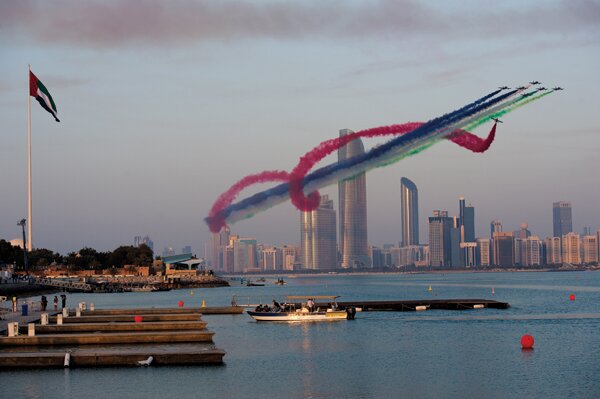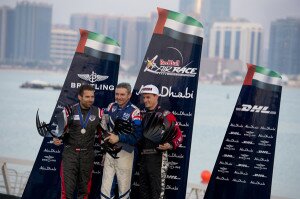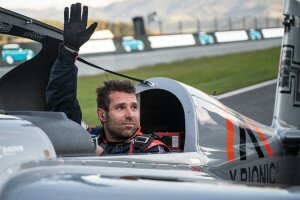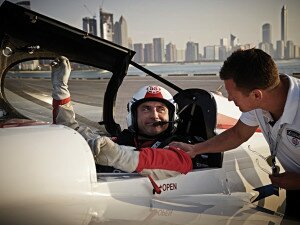The world’s best pilots take flight in Abu Dhabi as the capital hosts the season opener of the Red Bull Air Race
The Red Bull Air Race is the fastest motorsport series on the planet, one that sees the world’s most talented aerobatic pilots compete in a test of high-flying skill and precision.
In the inaugural season in 2005, ten hand-picked pilots took part in seven races around the world, including the US and Europe.
A decade later, 12 pros are going head to head in a series of eight international races, and it all kicks off in Abu Dhabi on 13th and 14th February.
Rise to the top
The international championship is a thrilling show of high speed, low altitude action.
The adrenaline-fuelled competition sees pilots race around an aerial track – usually 5km long – through 25m high inflated pylons called air gates.
Much like the heavily tested Formula 1 cars, the planes flown in the Red Bull Air Race are streamlined and agile. They must be light but strong and easy to manoeuvre. In previous years, pilots were allowed to modify their aircrafts. But since 2014, the engines and propellers have been standardised for all teams to establish a level playing field and ensure a high level of safety.
This year, there will be two categories: Master Class – which features 12 pro pilots – and Challenger Cup – which gives a younger generation of pilots the chance to compete in a less-pressured environment.
It takes an exceptional pilot to compete in the Red Bull Air Race. All participants are experienced flyers, as they must have clocked up thousands of air miles before being considered for the championship.
The pilots must obtain an unrestricted superlicence, which is issued by the Red Bull Air Race committee, before taking part. After meeting the committee’s criteria – which includes top accolades in international flying competitions and being an active aerobatic display pilot – they are given a restricted superlicence, which allows them to compete in the Challenger Cup.
After the first race in the UAE capital, the season heads to Chiba, Japan; Sochi, Russia; Budapest, Hungary; Ascot, England; Spielberg, Austria and Fort Worth, Texas, US, before culminating in Las Vegas, Nevada, US, on 17th and 18th October.
No two races are the same as the extreme heat, shifting wind and storms all affect flying conditions.
At each leg of the championship, the pilots race a pre-determined track one at a time. Master Class competitors begin with two training days before heading into the qualifying day, the results of which determine the order on race day.
On race day, the pilots compete in heats based on their qualifying times. The six winners of each heat, plus the two fastest losers, move forward into the Super 8. The fastest four will then advance into the Final 4, and compete for podium glory. The winner is the pilot who places first in the final flying session.
For every win, pilots earn 12 points, nine points for second place, seven for third, five for fourth and so on. The Red Bull Air Race World Champion is the pilot with the highest accumulated points throughout the season.
Competitors in the Challenger Cup race on a simplified track under the same rules as the masters. These pilots also have two training sessions before their official race. They must complete two laps, and their times determine their ranking.
Challenger Cup participants must compete in at least three races of the season. If they compete in more than three, only their top three scores are counted.
Ten points are given to the winner of each race, eight points for second place, six for third and so on. The Challenger Cup is awarded to the pilot with the highest overall score at the end of the season.
Challenger competitor Juan Velarde from Spain tell us, “My first Red Bull Air Race was in Abu Dhabi in 2014. It’s not easy to describe how I felt, but it was one of the best experiences of my life. After so many years of hard work and dedication I was competing among the best pilots in the finest competition on the planet. You can imagine how satisfied, motivated and thrilled I was.”
So how is the newbie preparing for the 2015 season?
“I arrive in Abu Dhabi with a new team. I have to adapt my style to the new plane and try to perform smooth and consistent lines on the track, rather than trying to be the fastest. We will also have to work on the plane to make it competitive.
“Our aim for this race is to get the team work as coordinated and effective as possible and to get a fast plane. I have to be realistic; I’m not thinking about finishing near the top. Nevertheless, I will do my best to minimise the period of adaptation to the new plane and start to fly fast: the sooner, the better.”
It’s anyone’s game
Last year’s Master Class saw Briton Nigel Lamb clinch the title with 62 points. Rivals Hannes Arch and Paul Bonhomme came in at second and third with 53 and 51 points, respectively.
But Nigel isn’t resting on his laurels. The 57-year-old lists fellow racers Hannes, Paul and Nicolas Ivanoff as his toughest competition. But he knows any pilot who’s consistent in his flying can steal the trophy at the end of the season.
Having competed in five seasons of the Red Bull Air Race, freestyle pilot and all-round thrill seeker Hannes is one of the championship’s most celebrated and competitive pilots.
The experienced aviator is no stranger to the podium, having won the world title once and placed second twice. But Hannes knows he’ll face tough competition from arch enemy Paul and the other pilots in 2015.
Despite being the most successful pilot in the history of Red Bull Air Race, double world champion Paul admits that he underestimated the competition last year. The veteran – who’s had 39 podiums and 15 race wins in his Red Bull Air Race career – is ready to face the new season head on.
“Last year I wasn’t pushing myself in the training or qualifying runs; I was trying to find the boundaries in the race,” Paul says. “You have to go to the limit as soon as possible, so when you’re in the final you know exactly how far you can push the plane. You can fly within the limit and not make any mistakes but you’ll be last.”
Czech Air Force pilot Martin Šonka had his glory in 2014, when he took the podium for the first time at the Abu Dhabi race. The former fighter pilot joined the race in 2010. At 31, he was the second youngest pilot in the sport’s history, after Canadian Pete McLeod competed in 2009 aged 25.
Then there’s Frenchman François Le Vot, a former French Air Force fighter pilot with over 4,000 flight hours under his belt. François placed fourth in the Challenger Cup last year but this year flies with the big boys in the Master Class.
Hannes Arch
Austria’s Hannes was the first European to win the Red Bull Air Race title in 2008. But aside from being a fierce competitor in the world’s fastest motorsport, the adrenaline-junkie has climbed some of the world’s highest mountains and jumped off various cliffs.
The decorated pilot began his career aged 16, focusing on hand gliding. He later became one of the world’s first ‘acrobatic paragliders’ and began experimenting with motorised aerobatics in 1998 when he joined the Swiss National Aerobatic Team.
Hannes admits that his first year as a rookie Red Bull Air Race pilot was more challenging than he ever imagined.
You’re clearly a thrill seeker. Why did you get into adrenaline sports?
It is my passion for adventure, to live life 100 per cent. It is not the search for adrenaline, it is a journey that lets me learn about myself and my possibilities.
There is a strong connection to nature. Flying makes you feel small and you feel humble towards life, which is important these days.
Do you remember your first flying experience?
I remember taking off the ground for the first time with a hang glider; it was a mixture of excitement, respect, freedom and the feeling of being at one with the elements. Later, after over 1,000 hours of flying as a hang glider, paraglider and skydiver, I got my private pilot licence to fly motorised flying machines then my aerobatic pilot and air race pilot licence.
How did you get involved in Red Bull Air Race?
I started for two years as a race director. In 2006 Red Bull gave me the chance of doing the one-year training process to qualify for the air race. In the same year, I was European Champion in freestyle; in 2008 I was World Champion.
Do you have to prepare mentally before you step into the plane?
Always. I have special exercises to focus for the races; I try not to lose the respect of the privilege of getting airborn.
You also fly helicopters and perform aerobatics in planes. Which do you prefer?
Both, because it is like flying with my body. At the end you do not realise that you have an aircraft fixed around you: this is the freedom of flying, not operating big aeroplanes, which is completely different.
Do you still consider Paul your biggest rival?
Yes, and Pete; I have a lot of respect for their approach to competition.
Paul Bonhomme
Racing ace Paul has participated in all 58 races in the history of the championship.
He’s been described as a ‘quintessential British gentleman’ who’s popular with fellow pilots, fans and the media. But don’t let the friendly exterior fool you: Paul has a competitive mean streak.
Paul comes from a family of aviators. He began his career aged 16, before gaining his flight instructor licence and moving into commercial flying.
When he’s not racing, Paul is a commercial airline captain who flies Boeing 747s.
You’ve been competing in Red Bull Air Race since 2005. Do you ever tire of competing?
No. The competition aspect is what keeps us all alive! As with any activity, there are always aspects that aren’t fun – such as cleaning a muddy bike used in enduro – a tough style of mountain biking – after a four-hour ride. But climbing into an aeroplane to fly around a race track is at the top of the list when it comes to fun.
A lot of people may underestimate the level of fitness that’s required to race planes. What kind of training do you do to prepare?
I cycle and spend time on a rowing machine. I also really enjoy hiking up mountains wherever I am in the world. Fitness is key to keep your mind sharp when you really need to be at peak concentration. It is no good approaching an air gate at 200mph while feeling tired.
You’re also a commercial airline captain. Which do you prefer flying, a Boeing 747 or race plane?
I love both and they are perfect antidotes to each other. After a week of one activity, it is great to be able to swap to the other. As for a preference, it is always whichever one I am in at the time.
What are you looking forward to about the Abu Dhabi race?
I’m currently in the UK and it is cold, windy and very wet. So I’m looking forward to some warmth. I’m also excited to race again, and I love Abu Dhabi.
Who is your toughest competition this year?
All of the others!
Do you have any plans to hang up your racing wings?
No!
What is the best advice you’ve ever been given?
I’ve been lucky to have been given lots of good advice. The two key pieces are: keep it simple and take one step at a time.
The Red Bull Air Race will take place along Corniche West, near Hiltonia. General admission is free. Hospitality packages are available: Race Club access includes seating, an open buffet and bar, a Red Bull souvenir and reserved parking from AED 600. Access to the VIP Sky Lounge includes hospitality facilities, gourmet menus, a complimentary bar, air conditioning, a Red Bull souvenir and exclusive parking from AED 2,300.
For more information contact: [email protected] or visit Virgin Megastore in Abu Dhabi Mall, Al Wahda Mall or Yas Mall.
The action begins at 1pm on 13th February and noon on 14th February.
For more information visit: www.redbullairrace.com
Rachael Peacock























